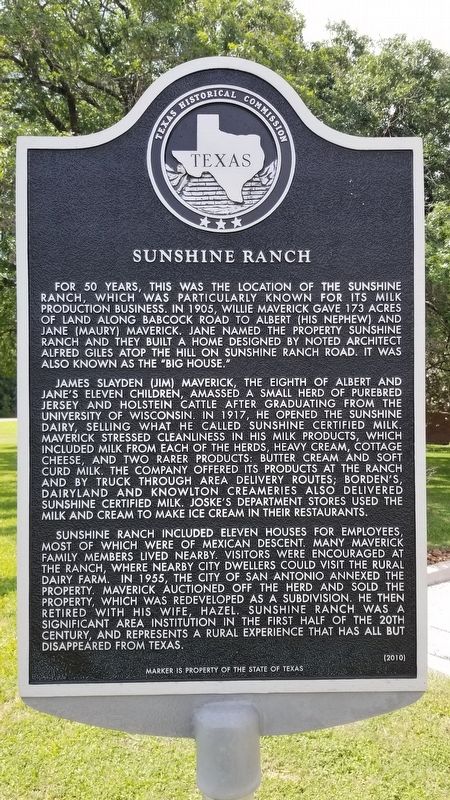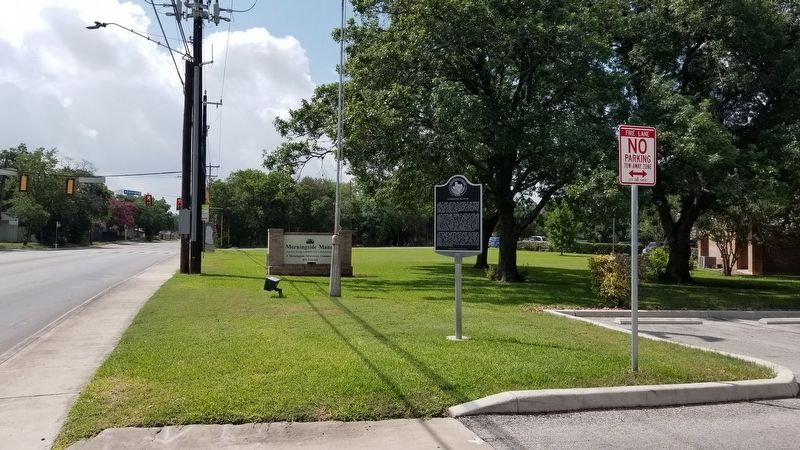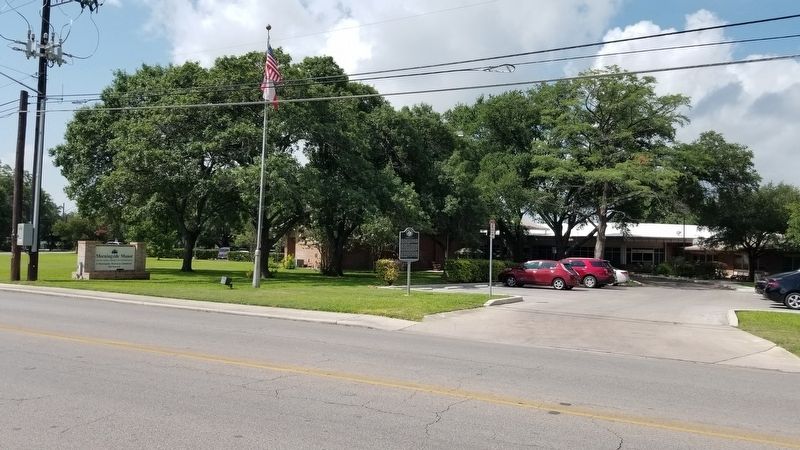Maverick in San Antonio in Bexar County, Texas — The American South (West South Central)
Sunshine Ranch
For 50 years, this was the location of the Sunshine Ranch, which was particularly known for its milk production business. In 1905, Willie Maverick gave 173 acres of land along Babcock Road to Albert (his nephew) and Jane (Maury) Maverick. Jane named the property Sunshine Ranch and they built a home designed by noted architect Alfred Giles atop the hill on Sunshine Ranch Road. It was also known as the "Big House."
James Slayden (Jim) Maverick, the eighth of Albert and Jane's eleven children, amassed a small herd of purebred Jersey and Holstein cattle after graduating from the University of Wisconsin. In 1917, he opened the Sunshine Dairy, selling what he called Sunshine certified milk. Maveric stressed cleanliness in his milk products, which included milk from each of the herds, heavy cream, cottage cheese, and two rarer products: butter cream and soft curd milk. The company offered its products at the ranch and by truck through area delivery routes; Borden's, Dairyland and Knowlton Creameries also delivered Sunshine certified milk. Joske's department stores used the milk and cream to make ice cream in their restaurants.
Sunshine Ranch included eleven houses for employees, most of which were of Mexican descent. Many Maverick family members lived nearby. Visitors were encouraged at the ranch, where nearby city dwellers could visit the rural dairy farm. In 1955, the city of San Antonio annexed the property. Maverick auctioned off the herd and sold the property, which was redeveloped as a subdivision. He then retired with his wife, Hazel. Sunshine Ranch was a significant area institution in the first half of the 20th century, and represents a rural experience that has all but disappeared from Texas.
Erected 2010 by Texas Historical Commission. (Marker Number 16387.)
Topics. This historical marker is listed in these topic lists: Animals • Hispanic Americans • Industry & Commerce. A significant historical year for this entry is 1905.
Location. 29° 28.611′ N, 98° 32.895′ W. Marker is in San Antonio, Texas, in Bexar County. It is in Maverick. Marker is at the intersection of Babcock Road and St. Cloud Road, on the right when traveling south on Babcock Road. The marker is located in front of an Assisted Living facility. Touch for map. Marker is at or near this postal address: 602 Babcock Road, San Antonio TX 78201, United States of America. Touch for directions.
Other nearby markers. At least 8 other markers are within 4 miles of this marker, measured as the crow flies. Wesley Peacock House (approx. 1.8 miles away); St. Mary's University (approx. 1.8 miles away); Limestone Lintel from Old St. Mary's College (approx. 1.9 miles away); Rattler (approx. 2 miles away);
Protestant Home for Destitute Children (approx. 2.6 miles away); Audie Leon Murphy (approx. 2.8 miles away); Kings Highway Camino Real — Old San Antonio Road (approx. 3.4 miles away); The Woman's Club of San Antonio (approx. 3˝ miles away). Touch for a list and map of all markers in San Antonio.
Also see . . . Dairy Cattle.
Very few cattle used exclusively for dairy purposes were found in Texas before the 1880s. Before that, of course, most farmers, planters, and townspeople kept cows, drank milk, and made butter and possibly cheese, but the cattle that produced for them were almost all general purpose and were also used for beef and as draft animals. Since the cattle industry in Texas mostly stemmed from Spanish or Mexican roots, and longhorn cattle were known as "exceedingly poor milkers," early Texas milk cows produced small quantities of milk compared to late-twentieth-century Holstein cattle. Very likely, a few Durhams, Devons, and Ayrshires were brought into Texas by Anglo-Americans before the Civil War, since those breeds were present in other southern states. Before the 1880s, however, there was only a small amount of commercial production from dairy cows near the larger towns and among German-Americans in Texas. The only place such commercial milk production existed was in the rougher, non-planting land around such towns, and thus the few cattle used primarily for dairy purposes could be found in those regions. There were probably already grade or mixed versions of both Jerseys and Holsteins in Texas, but in 1880 the first purebred Jerseys were imported, and in 1884 the first purebred Holstein calves were born in the state. These became the two main breeds in Texas dairy history. In the late 1800s and early 1900s Jerseys coming from other southern states were far more popular than any other dairy breed. One reason was that they were more resistant to tick fever (see TEXAS FEVER) than Holsteins or Ayrshires imported from the north. A second, more significant, reason for their popularity was that until the mid-1900s most milk was marketed as cream, butter, or cheese rather than as whole milk, and Jerseys produced milk with a high butterfat content. In 1949, 75 percent of the estimated 1,283,000 milk cows in Texas were Jerseys. Source: The Handbook of Texas(Submitted on June 28, 2021, by James Hulse of Medina, Texas.)
Credits. This page was last revised on February 2, 2023. It was originally submitted on June 27, 2021, by James Hulse of Medina, Texas. This page has been viewed 946 times since then and 205 times this year. Photos: 1, 2, 3. submitted on June 27, 2021, by James Hulse of Medina, Texas.


